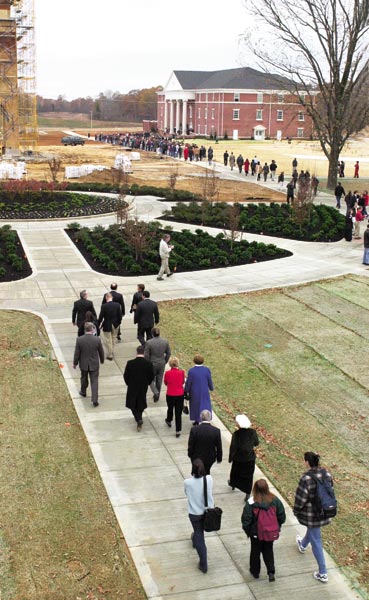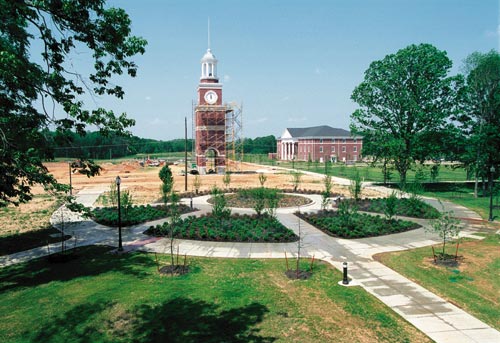 |
||||||
 Union is not exactly building a baseball diamond in a cornfield, but over the past five years a field of dreams has turned into a reality. A bold vision has begun to take shape with the addition of new buildings, property enhancements, additional roads and sidewalks, and the development of the Great Lawn on the West Campus. Union is not exactly building a baseball diamond in a cornfield, but over the past five years a field of dreams has turned into a reality. A bold vision has begun to take shape with the addition of new buildings, property enhancements, additional roads and sidewalks, and the development of the Great Lawn on the West Campus.
On December 5, 1997, the Board of Trustees at Union University unanimously adopted a Campus Master Plan that would build, enhance, and shape the campus over the next 15 to 20 years. The plan has three phases, the first of which is now dramatically changing the appearance of the campus.
Building for the Future The Lifeway Christian Bookstore has been a great addition for the campus and community. It seeks to combine all the services of a campus bookstore with the resources of a nationally recognized store. Union’s partnership with Lifeway is unique and has been a work in progress. However, the store has been a great asset to the campus in many ways, explains President David S. Dockery. As Hammons Hall drew to completion, a buzz of activity began across campus. The West Campus was taking shape with the development of Jennings Hall, Miller Tower, and the Great Lawn. Over two years into the process, the change is breath-taking. The 120-foot brick clock tower will anchor the new Great Lawn. The area will be a central gathering place for students and serve as a beautiful backdrop for special events such as graduation. The stunning tower and beautiful landscape shares the West Campus with an equally impressive Jennings Hall. “Jennings Hall will meet pressing needs for our growing campus, providing state-of-the-art facilities for our music and communication arts departments and much needed space for Union's nationally acclaimed Christian Studies Department,” said Dockery. “We thank God for His continued blessings to this university.” Jennings Hall, which was officially dedicated in December 2000, provided a state of the art facility for the departments of music, communication arts, and Christian studies. The 45,000 square foot building was the first academic building to be constructed on Union’s campus in 15 years. That is what the vision for the Campus Master Plan is about – building for the future. But the task has not been easy. A great amount of time has gone into clearing and grading the land, setting up drainage systems, installing sidewalks, irrigation, and lighting, and landscaping.
A Face lift around campus Tiered classrooms were created in the Penick Academic Complex, and the chemistry and physics laboratories were upgraded. Union Station, which is a central part of life for Union students, was added in the main lobby. Union Station centralized several student and business services. It serves as an information center, registration location, main switchboard, and payment center. Elsewhere around campus many other changes have taken place. Two new entrances were created, the north entrance off Union University Drive (formerly Channing Way) and another off Pleasant Plains Extended. Athletics has also benefited from the expansion. A new softball and baseball complex and a soccer field were built. The complex is complete with a new concession/press box area and lighted fields. As enrollment has increased so has the number of students living on campus. To meet the growing need, the Watter's complex received renovations and two single student housing facilities were added by August 1999. The growing number of students also needed more space to fill their stomach while feeding their minds. The original snack bar in the Student Union Building was renovated and reopened as The Lexington Inn. This gave students more space and more options. One major expansion is not obvious from the Jackson Campus. Union University recently purchased a facility from Immanuel Baptist Church in Germantown, Tenn. The new facility, dedicated in September 2000, provides a permanent place for growing graduate programs in education, business, and nursing.
“As you look around at all the changes that have occurred over the past five years, it is obvious that God is blessing the campus. It also serves as a reminder of the strong legacy and promising future of Union University,” Dockery explains. A vision does not become a reality without support and leadership. In December 1997 the Board of Trustees put forward a vision of what Union’s campus could become over the next 20 years. In 1998, a five-year, $35 million capital campaign was launched to fund the first phase of the master plan. The support from alumni and friends of the university was so overwhelming that a new campaign, appropriately called “Building a Future,” extended the goal to $60 million. Over $36 million has already been committed to turn a vision into a reality. “The changes over the past five years have been exciting to watch,” said Gary Carter, Vice President for Business Services. “Union University is fortunate to have leaders like David Dockery and the members of the Board of Trustees. Many alumni and community members have given time and resources to make this a reality.” And this is only the beginning. With a new Science Building and an Athletic Convocation Center being planned, the campus will continue to grow to meet the needs of students and the community.
|



